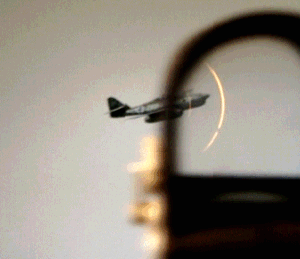| Reflector sight | |
|---|---|
| Classification | Sight |
| Industry | Arms |
| Application | Aiming point |
| Inventor | Howard Grubb |
| Invented | 1900 |

A reflector sight or reflex sight is an optical sight that allows the user to look through a partially reflecting glass element and see an illuminated projection of an aiming point or some other image superimposed on the field of view.[1][2] These sights work on the simple optical principle that anything at the focus of a lens or curved mirror (such as an illuminated reticle) will appear to be sitting in front of the viewer at infinity. Reflector sights employ some form of "reflector" to allow the viewer to see the infinity image and the field of view at the same time, either by bouncing the image created by lens off a slanted glass plate, or by using a mostly clear curved glass reflector that images the reticle while the viewer looks through the reflector. Since the reticle is at infinity, it stays in alignment with the device to which the sight is attached regardless of the viewer's eye position, removing most of the parallax and other sighting errors found in simple sighting devices.
Since their invention in 1900, reflector sights have come to be used as gun sights on various weapons. They were used on fighter aircraft, in a limited capacity in World War I, widely used in World War II, and still used as the base component in many types of modern head-up displays. They have been used in other types of (usually large) weapons as well, such as anti-aircraft gun sights, anti-tank gun sights, and any other role where the operator had to engage fast moving targets over a wide field of view, and the sight itself could be supplied with sufficient electrical power to function. There was some limited use of the sight on small arms after World War II, but the sight came into widespread use during the late 1970s with the invention of the red dot sight. This sight uses a red light-emitting diode (LED) as its illumination source, making a durable, dependable sight with an extremely long illumination run time.
Other applications of reflector sights include sights on surveying equipment, optical telescope pointing aids, and camera viewfinders.
- ^ "Elementary Optics and Application to Fire Control Instruments". Headquarters, Department of the Army. 13 April 1977. Retrieved 13 April 2018 – via Google Books.
- ^ Company, McGraw-Hill Book (13 April 2018). McGraw-Hill encyclopedia of science and technology. McGraw-Hill. ISBN 9780079136657. Retrieved 13 April 2018 – via Google Books.
{{cite book}}:|last=has generic name (help)